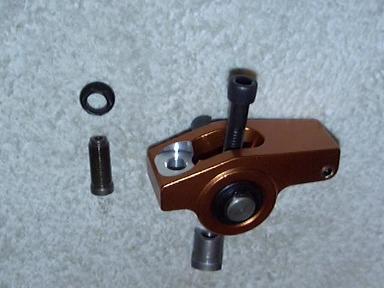As stated or inferred by everyone else the limiting factor in a bolt down rocker arm is the skimpy 5/16" cap screw that holds it to the pedestal. In comparison the adjustable rocker arms that require machining the pedestals use a much more substantial 7/16" cap screw or stud.

The RM Competition rocker arm (pictured above) doesn't use any kind of substantially different fastener to secure it to the pedestal. I don't know of anyone using them. It would be nice to be able to substantiate Mr Malik's claim.
In the good ol' days we limited use of the 5/16" cap screw to the types of spring forces that were common to "hot" hydraulic cams in that era, about 350 pounds over the nose at the most. Any spring force more than that and the recommendation was to use the 7/16" stud type mounting system. I'm not a fan of push rod guided rocker arms however, I never have been.
If your motor's over the nose spring force is 350 pounds or less then its a slam dunk, go for one of the bolt down rocker systems using the oem 5/16" fastener. Or use the stock rocker arm in conjunction with the Crane roller fulcrum kit. If the over the nose spring force is more than 350 pounds my recommendation is to play it safe.
Another adjustable bolt down rocker arm similar to the RM Competition arm is manufactured by Yella Terra, model YT6015. Yella Terra also manufactures a substantially stronger rocker arm of similar design using a 7/16" fastener, model YT6321. Both rocker arms are choice quality stuff, but the YT6015 is limited by that 5/16" cap screw.
You can find pictures of the Yella Terra parts in my 351C technical photo album on FaceBook, see thelink below.
______________________________________
In regards to your motor's compression ratio, its impossible to calculate it exactly without knowing the following information:
(1) deck clearance
(2) head gasket thickness
(3) combustion chamber volume
Assuming those dimensions are nominal your static compression ratio will be one of the following:
(1) Using Australian quench chamber 2V heads - 10.76:1
(2) Using 1970 US 4V heads (D0AE castings) - 10.15:1
(3) Using 1971 US 4V heads (D1AE castings) - 9.82:1
-G


